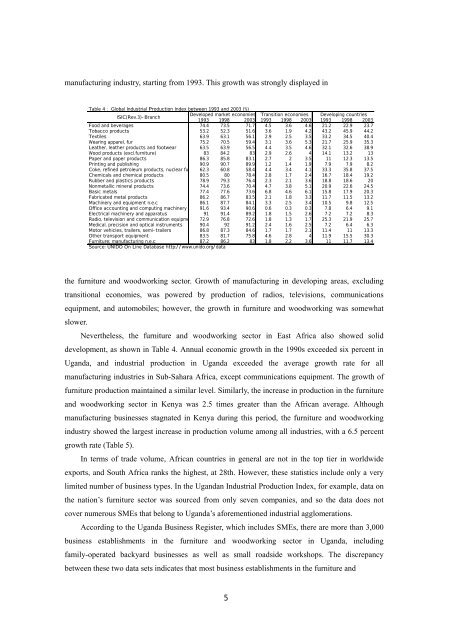Information - ARRIDE - IDE-JETRO
Information - ARRIDE - IDE-JETRO
Information - ARRIDE - IDE-JETRO
Create successful ePaper yourself
Turn your PDF publications into a flip-book with our unique Google optimized e-Paper software.
manufacturing industry, starting from 1993. This growth was strongly displayed in<br />
<br />
<br />
<br />
<br />
<br />
<br />
<br />
<br />
<br />
<br />
<br />
<br />
<br />
<br />
<br />
<br />
<br />
<br />
<br />
<br />
<br />
<br />
<br />
<br />
<br />
<br />
<br />
the furniture and woodworking sector. Growth of manufacturing in developing areas, excluding<br />
transitional economies, was powered by production of radios, televisions, communications<br />
equipment, and automobiles; however, the growth in furniture and woodworking was somewhat<br />
slower.<br />
Nevertheless, the furniture and woodworking sector in East Africa also showed solid<br />
development, as shown in Table 4. Annual economic growth in the 1990s exceeded six percent in<br />
Uganda, and industrial production in Uganda exceeded the average growth rate for all<br />
manufacturing industries in Sub-Sahara Africa, except communications equipment. The growth of<br />
furniture production maintained a similar level. Similarly, the increase in production in the furniture<br />
and woodworking sector in Kenya was 2.5 times greater than the African average. Although<br />
manufacturing businesses stagnated in Kenya during this period, the furniture and woodworking<br />
industry showed the largest increase in production volume among all industries, with a 6.5 percent<br />
growth rate (Table 5).<br />
In terms of trade volume, African countries in general are not in the top tier in worldwide<br />
exports, and South Africa ranks the highest, at 28th. However, these statistics include only a very<br />
limited number of business types. In the Ugandan Industrial Production Index, for example, data on<br />
the nation’s furniture sector was sourced from only seven companies, and so the data does not<br />
cover numerous SMEs that belong to Uganda’s aforementioned industrial agglomerations.<br />
According to the Uganda Business Register, which includes SMEs, there are more than 3,000<br />
business establishments in the furniture and woodworking sector in Uganda, including<br />
family-operated backyard businesses as well as small roadside workshops. The discrepancy<br />
between these two data sets indicates that most business establishments in the furniture and<br />
5




![Title [書評] 廣田義人著『東アジア工作機械工業の技術形成 ... - ARRIDE](https://img.yumpu.com/47139953/1/184x260/title-arride.jpg?quality=85)






